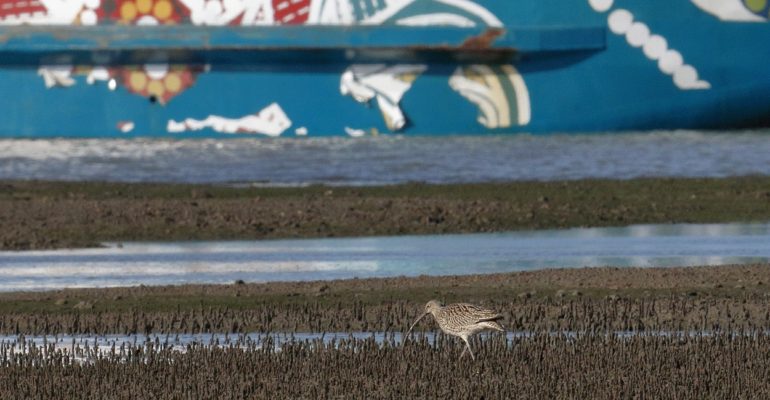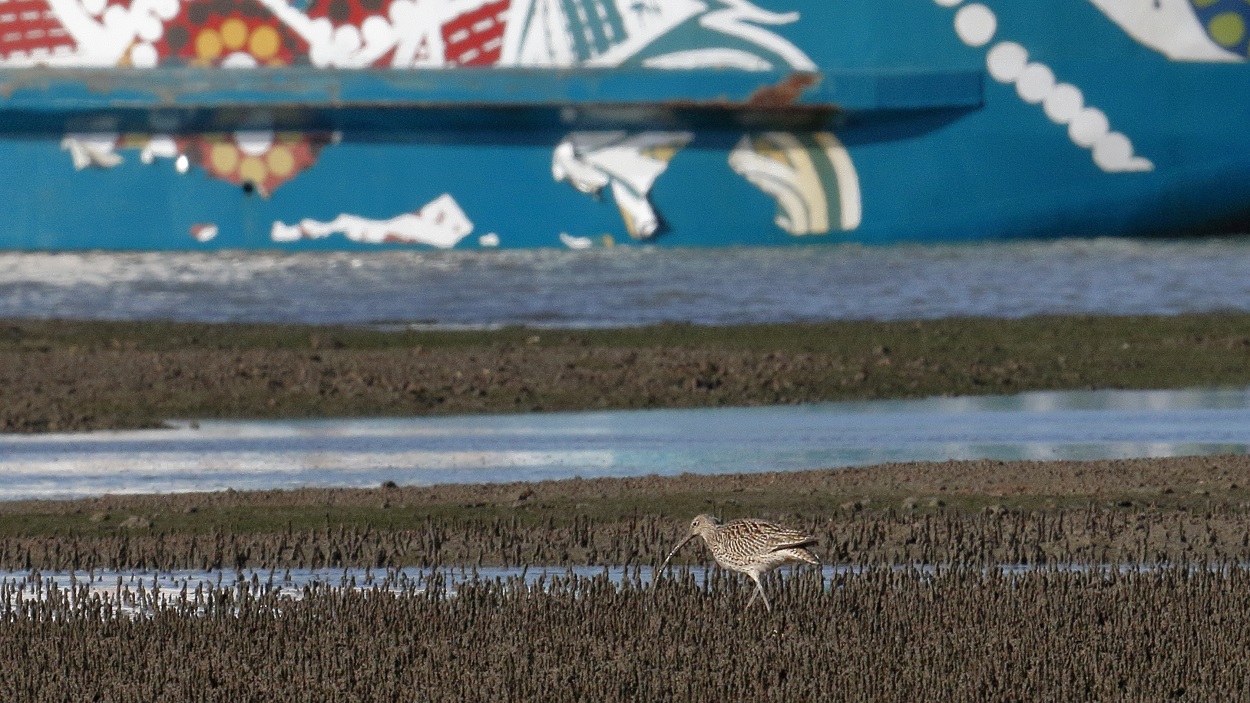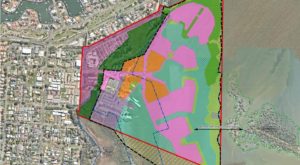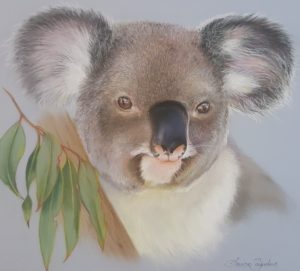

Development at Toondah Harbour could contribute to extinction of the critically endangered Eastern curlew.
Australia’s unique wildlife is a reason why many tourists visit this country but many of our mammals, birds and other fauna are threatened with extinction, and others no longer exist.
Since 1788 more than 50 bird, mammal and frog species have become extinct in Australia. Our loss of mammal species is the worst in the world.
With ‘business as usual’ approaches to wildlife conservation it’s expected that 17 more bird and mammal species will become extinct over the next 20 years. Australia’s diverse range of reptile species is also under threat with 7% “on the verge of extinction”.
Becoming listed as a threatened species in Australia may not ensure survival. The Guardian reports that:
Less than 40% of Australia’s nationally-listed threatened species have recovery plans in place to secure their long-term survival.
Senate inquiry into wildlife extinction
Australia’s conservation of threatened fauna species is being examined by a Senate committee inquiry with terms of reference that include species decline, wildlife protection laws and funding for threatened species.
The public can make submissions to the Senate’s inquiry (Australia’s Faunal Extinction Crisis) until 10 September 2018. Guidelines for making a submission are available on the inquiry home page.
Calls for stronger laws to protect Australia’s natural world are being advocated forcefully by a number of organisations including:
- Australian Conservation Foundation
- Wilderness Society
- Humane Society International
- Birdlife Australia
- The Australian Panel of Experts on Environmental Law
Threatened wildlife of the Redlands Coast

An area now branded as naturally wonderful Redlands Coast is home to many species classified by the Federal Government as Critically Endangered or Endangered, including:
- Three migratory shorebird species (Eastern Curlew, Great Knot and Curlew Sandpiper)
- Three species of turtle found in Moreton Bay (Leatherback, Loggerhead and Olive Ridley)
Koalas, which suffered an alarming 80% population decline in the Redlands from 1996 to 2014, are considered Vulnerable (that’s vulnerable to extinction) in Queensland and NSW.
In Queensland, the State Labor Government’s response to an expert panel report is proceeding very slowly with minimal community engagement.
Other Vulnerable mammal species found in Redlands include the Greater Glider and Grey-headed flying fox.
Dugongs, three more turtle species (Green, Hawkesbill and Flatback) and another migratory shorebird (Bar-tailed godwit) are also listed as Vulnerable by the Federal Government under the Environment Protection and Biodiversity Conservation (EPBC) Act.
Moreton Bay’s population of Australian Humpback dolphins is another species threatened with extinction. While not yet listed by the Federal Government, in Queensland this species is classified as Vulnerable.
Toondah Harbour project’s impact on threatened species

Walker Group’s latest plans for development at Toondah Harbour
Walker Group’s proposed 3,600 dwelling residential project at Toondah Harbour would have a significant impact on threatened species currently living in the Redlands.
Extra vehicle traffic and other disturbance from 3,600 new dwellings would most likely wipe out a healthy koala population living in the area around Toondah Harbour.
Proposed dredging in an area of Ramsar wetlands would destroy important feeding grounds used by Eastern curlews and Bar-tailed godwits.
The Federal Government decided in July 2018 that Walker Group’s third version of a development plan should be assessed by an environmental impact study in accordance with the EPBC Act. The draft guidelines for this study have not been made publicly available.
Threatened Species Day on 7th September

Toondah koala Airlie drawn by Louise Saunders
The importance of protecting threatened species in Australia is remembered on 7th September, the anniversary of when the last known Tasmanian tiger (Thylacine) died in 1936.
Redlands2030 is promoting awareness of Threatened Species Day in Redland City.
We will be conducting a raffle, drawn on Threatened Species Day, for an original pastel drawing of Toondah koala mum Airlie. Raffle proceeds will go to the Redlands Koala Action Group.
Airlie died of natural causes in May 2018, a few hundred metres away from Toondah Harbour. The area where she lived included some habitat cleared for construction of apartments a few months earlier.
This fine drawing of Airlie has been kindly donated by Louise Saunders, a highly regarded wildlife artist based in Cleveland.
Other prizes for the Redlands2030 raffle will include a copy of the The Eastern Curlew, a recently published work signed by its author Harry Saddler.
Redlands2030 – 8 August 2018
Update: Today the Senate Committee advised on its website that it has agreed to extend the date for the receipt of submissions from 13 August 2018 to 10 September 2018.
Please note: Offensive or off-topic comments will be deleted. If offended by any published comment please email thereporter@redlands2030.net
6 Comments
Lynn is correct in stating Redlands was at one time known as the ‘Koala Coast’. My deepest regret is not having met the late Terry Mackenroth personally. Its said there is no fool like an old fool which describes me perfectly. I had a petition with over 300 signatures in an effort to save a protected wetland site in Capalaba, which was under special protection in the Koala Coast policy. Deals were done by then head town planner, Birkdale Cr Beard, Cr Burns, Wello Pt lawyer, with commercial developer Peter Endacott, who destroyed the riparian zone on Coolnwynpin Creek 29-37 Moreton Bay Rd where today area is inaccessible to locals due to towering concrete walls creating a haven for social misfits. Only with the demise of the late Terry Mackenroth did I learn my brother knew the man personally due to his involvement with Little League Club in Carina, described to me as a man who was respected by both sides. I had made appt with Env Min Rod Welford and saw his advisor handing him the photos of the wetland site. I didn’t think about what was behind it, but received a request to pick up a female from an office to accompany me to Mr Welford’s office. Recall waiting a while, then walked together to the minister’s office but the girl disappeared. While waiting by the desk, Mr Welford walked out of his office, and we spoke. He asked ‘where are you from?’ said Capalaba…with that, he turned and walked to the elevator.!?
Entering office of the advisor, young woman sat in chair front of desk and took over. She then asked me to wait outside, meeting was going well, and we would hear from Mr Mackenroth re saving the wetland site. No we didn’t and on following up, got a call from Redland Council telling me I was never to contact the young lady who accompanied me ever again. I then made appt with Ombudsman but 2 pairs of ears listened in, as I needed to know date and who were present when zoning was changed from ‘special protection’ to ‘commercial’. As I said, there is no fool like an old fool. Had I known my brother knew Terry Mackenroth personally, knowing the kind of man he was, feel we may have been successful in saving this once precious oasis, a koala haven, for the people.
The meeting last night at My Horizons Convention Centre next door to Indigiscapes in Capalaba was a real eye opener on integrity and accountability in local government and council. It was convened by the Queensland State Members for Redlands, Kim Richards, and Capalaba, Don Brown. The two speakers were Dr Nikola Stepanov, Qld Integrity Commissioner, and Alan MacSporran QC, Chairperson for Crime & Corruption Commission (CCC). There were at least four councillors present from Redland City Council (RCC), which was pleasing to see because the discussion centred around corruption, perceived corruption and conflicts of interest within government bodies. No doubt these councillors are now well informed, like the rest of us, on what is acceptable and what is not by our elected representatives. It is now high time to stop donations from land and housing developers to councils and individual councillors in order to gain influence in decision making. Residents in the Redlands have been calling out this behaviour for a number of years now and no doubt this is obvious to the conveners, Kim Richards and Don Brown. It is to their credit that such a meeting was convened because most of us do not want to see Redland City Council in the same boat as Ipswich City Council.
THANKS Lindsay Hacket It would be interesting to cross reference the VMA maps March 2018 which have some of the Essential Habitat metadata missing with(the new target for developers RBVs) ,in the SEQ Regional Plan 2017- The Regional Biodiversity Values and Corridors etc on Map 5b . and Naturesearch Fauna obs . in order to plant back corridors
Healthy Land and Water have a recent methodology for mapping koala habitat using ;a wider number of R.E.s with Koala tree species , High Value Regrowth and 5 Koala observation sets. This does involve a small amount of modelling. The high Value regrowth in some LGAs supports half the koala observations.
A serious amount of threatened species data sits inside DES particularly on koalas and some waders in RCC . They should be declared Endangered.
The Ministers Koala Panel Report fails to come up with sufficient answers on ;Tree clearing ,70,000 ha of koala habitat unprotected in the Urban Footprint, Green Fauna Infrastructure (Xings and buyback by DTMR &LGAs) Sanctuaries and buyback and corridors. Invertebrates are threatened too.
Why do you think the Council is promoting “Redlands Coast” when it used to be the “Koala Coast”?
Pretty obvious to anyone who is concerned for our wildlife. Very cynical of Redland City Council to try to divert attention away from its destructive practices.
There are various proformas for Submissions. See the EDO website. The topic is critical and encyclopedic . There was a previous Senate Inquiry into Threatened Species circa 2012 but it had a poor response from LNP State Government and the Recommendations went the same way as the Hawke Report 2008 int0 the EPBC Act.
The EPBC Act does not seem to have saved a koala, although millions of dollars in offsets 8 years away comes too late for koalas and kangaroos at Flagstone PDA.
The EPBC Act produces EISs that do away with scrutiny which should be enforced under a State EIS but submitted by Federal Govt, State Govts , Local Govts, Quangos and Developers. Traffic Studies and Environmental Studies were hidden by DTMR in the Transurban Logan Enterprise Precinct(LEP) federal EIS . There is a parallel here at Toondah for other documents .
The threatened species are now subject to SEAP and the Common Assessment Method (CAM) for trying to “normalise” classifications across 3 levels of Government . Trying to get species up to Threatened or Endangered classification is now a formidable ,time consuming and costly battle .
A Koala report by Dr David Paull for the Endangered Port Stephens Koalas has been dumped by NSW State Government . This is being challenged by Australians For Animals , but it is dangerous precedent for many species and the SEQ Koalas which should be classified as Endangered, now facing multiple Threatening Processes.
Redlands Biodiversity in Danger. A paper by Lindsay Hackett, dated 23 June 2009. Bad then, worse now.
See: https://www.scribd.com/document/21395355/Redland-Biodiversity-in-Danger.
Redlands 2030 Community Plan – The Environment. A paper by Lindsay Hackett, dated 02 June 2009. More detail about endangered species.
See: https://www.scribd.com/document/21395074/Redland-2030-The-Environment-Protected-Matters-Flora-and-Fauna.